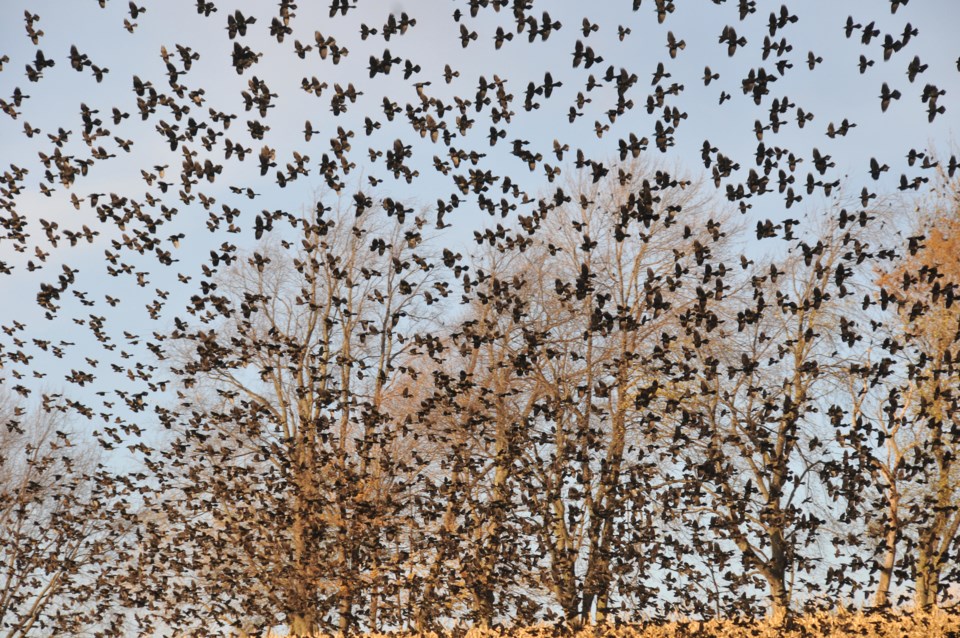The flock of blackbirds seemed endless in length as it flew across the road, the dotted ribbon of movement undulating slightly when some birds clumped together. How many birds? Perhaps several hundred, perhaps a thousand, it was impossible to keep count.
These large flocks of autumn migrants are impressive to see, whether appearing in a long line of follow-the-leader or looking like a mass of compressing and decompressing molecules. Whether they be starlings, sandpipers, Canada geese or grackles, a well-orchestrated flock manoeuvre is a pretty awesome sight to behold.
Once viewed, the immediate question that comes to mind is, "how can they coordinate themselves to do that?" The reasons to form a flock in the first place are straightforward: either to avoid a predator (safety in numbers); or to utilize air turbulence from a bird ahead to make the next bird's flight easier (a la Canada goose way of thinking).
But when hundreds or thousands of individuals spontaneously wheel right, wheel left, drop, swing back, rise up and land as a 'single unit', the wow factor increases ten-fold.
Careful observations of flock movements, done by analyzing film played back at slow speed, reveals some of the mystery as to how the communication flows from bird to bird. There does not appear to be 'one leader' that decided when and where to swirl the flock, apparently the graceful ballet of the turn is the result of a mass and chaotic flinch instigated by an individual bird.
So let’s say Bob the Bird thinks he sees an impeding danger, such as a diving falcon. He flinches to the left. The birds of either side of him sees his move and they too flinch left, just to be safe.
Each of these birds were seen by another two birds each, and they too go left, which is noticed by their immediate neighbours who also turn left. This 'flinch to the left' spreads through the flock, from front to back, in milliseconds, with result being a lovely flow of bird movement to the left.
And then a bird on the left flank of the flock, upon seeing all his fellow flock-mates turning towards him, decides to gain a little altitude and hopefully find some space. This causes the two birds beside him to also react by flying up, which then causes the ripple effect through the whole flock, and in the blink of an eye the whole flock has gone from a left turn and is now a wave of rising birds.
And so it continues until an individual near the current front of the flock decides "enough of this nonsense" and lands. En mass the flock settles back to earth behind her. Pretty impressive for flash mob action.
The above understanding of flock manoeuvres comes from the research of Wayne Potts. He found that direction change can come from anywhere within the flock, even the rear, and spreads as a wave with awesome speed. The message to "turn left" takes a mere 15 milliseconds to be communicated from one bird to the next, but that speed is attained after the manoeuvre has commenced; the initial response time between nervous Bob the Bird, who flinched left in the first place, and his two buddies was 67 milliseconds.
The reason for the increased speed of communication is not that the birds in the centre of the flock are smarter, it has to do with chorus line dancers. Just as the seventh or eighth dancer in a line can see the high kick coming down the line, she can get ready and perform in perfect timing, but the second dancer may have been slightly out of synch (slower) as she was responding to the timing of just her immediate partner. Birds further back in the flock can 'see it coming' and therefore react with greater unison.
When flocks are flying between feeding areas or to a roost site, the movements may be more of a sway than a frantic turn. This is brought on by an individual on the flank who see something of interest, slips sideways for a better look, and suddenly has two thousand travelling companions doing the same thing.
The aerial dances of starlings and grackles will be continuing for a couple more weeks and then they'll be gone for the winter ... but wait until you see 8,000 snow buntings perform over a field near you! A site worth waiting for!



